new posts in all blogs
Viewing Blog: From Hook to Book, Most Recent at Top
Results 26 - 50 of 118
Statistics for From Hook to Book
Number of Readers that added this blog to their MyJacketFlap: 2
 It’s that time of year to flex your writing muscles and get your entries in to the fantastic number of competitions and exciting opportunities open to young writers right now. You’ll find further details and some cool new resources on my Young Writers’ Resources page, such as writing residencies, including: three great KSP places in WA, the Ray Koppe Residency – offering a week at Varuna Writers’ House; writing conferences, including: CYA Hatchlings combined with the full CYA program in July 2013 and the National Young Writers Festival blasting off in October 2013, plus lots more competition details, events and workshops.
It’s that time of year to flex your writing muscles and get your entries in to the fantastic number of competitions and exciting opportunities open to young writers right now. You’ll find further details and some cool new resources on my Young Writers’ Resources page, such as writing residencies, including: three great KSP places in WA, the Ray Koppe Residency – offering a week at Varuna Writers’ House; writing conferences, including: CYA Hatchlings combined with the full CYA program in July 2013 and the National Young Writers Festival blasting off in October 2013, plus lots more competition details, events and workshops.
All fabulous opportunities to get your writing in front of judges, publishers and selection panels and there’s some not insignificant cash prizes going.
So get those stories and poems in fast for those comps closing soon.
Some tips for success:
- Follow submission guidelines (exactly)
- Redraft, redraft, redraft
- Read your work aloud to pick up jars and jolts and to check for rhythm
- Vary your sentence structure
- Be strenuous at spell-checking and proofreading
- Flick off that fear goblin nagging on your shoulder. If you’ve put in the work – it’s ready. Repeat – flick and submit.
If anyone reading here knows of any writing opportunities or competitions for young writers, not listed on the YWR page, I’d love you to leave me the details in a comment or email me the link. Thnx.

to be a writer!
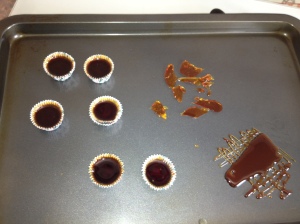 Got to love it when you get to make old-fashioned toffee in the name of research.
Got to love it when you get to make old-fashioned toffee in the name of research.
This batch is a tad bitter because I was trying to make it as if I couldn’t adjust the heat on the gas, since the toffee in my story is being made a very, very time long ago, under less than ideal conditions, in my new YA historical.
And since I must suffer for my art, I had to eat it too. It was actually very delicious toffee. But don’t tell anyone, because a writer’s life is supposed to full of bitter pills.
What fun/scary/fabulous things have you done lately for your art?

I have been tagged, in the writers’ blog chain The Next Big Thing, by the lovely and talented Corinne Fenton. The idea is that one one writer tags five more writers to talk about their Next Big Thing (project) and then those writers pass the baton on so that we can read about what lots of writers are writing about. So here we go with my Next Big Thing.
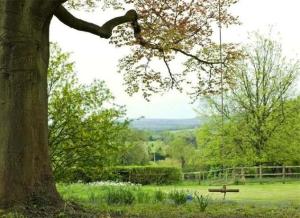 1) What is the working title of your next book?
1) What is the working title of your next book?
The Swing Tree
2) Where did the idea come from for the book?
 The Swing Tree began as a passion project after a visit to the State Coal Mine, Wonthaggi, exploring my family history back in 2008. My Irish great-grandparents journey to Australia from a tiny pit village in Scotland cried out as a backdrop in need of a story and so began a four-year love affair that has taken me to my ancestors’ birthplace, down a Lanarkshire coal mine and onto the battlefields of France.
The Swing Tree began as a passion project after a visit to the State Coal Mine, Wonthaggi, exploring my family history back in 2008. My Irish great-grandparents journey to Australia from a tiny pit village in Scotland cried out as a backdrop in need of a story and so began a four-year love affair that has taken me to my ancestors’ birthplace, down a Lanarkshire coal mine and onto the battlefields of France.
3) What genre does your book fall under?
Historical fiction
4) What actors would you choose to play the part of your characters in a movie rendition?

 Hmm, a tough question, especially since my main character, Maire, is Scottish and I’m not so familiar with Scottish actors. During the writing of The Swing Tree, I kept a photograph of the gorgeous Olive Thomas, star of the twenties silent movies, attached to my monitor as inspiration for Maire’s character. I think today, young Scottish actress Jayd Johnson would make a fabulous Maire. I can see James McAvoy playing the role of Liam. He’s cute and cheeky, but he would also bring the hard edge to Liam’s character when necessary.
Hmm, a tough question, especially since my main character, Maire, is Scottish and I’m not so familiar with Scottish actors. During the writing of The Swing Tree, I kept a photograph of the gorgeous Olive Thomas, star of the twenties silent movies, attached to my monitor as inspiration for Maire’s character. I think today, young Scottish actress Jayd Johnson would make a fabulous Maire. I can see James McAvoy playing the role of Liam. He’s cute and cheeky, but he would also bring the hard edge to Liam’s character when necessary.
5) What is the one-sentence synopsis of your book?
A young Scots immigrant follows the lad she loves to the far side of the world only to find him much changed and herself no part of his plans.
6) Will your book be self-published or represented by an agency?
Fingers crossed – an agency.
7) How long did it take you to write the first draft of the manuscript?
Two years for the first draft. The completed manuscript is now 120,000-words, but I would have written over 170,000-words during the four full years of writing, researching, rewriting and multiple drafts.
8) What other books would you compare this story to within your genre?
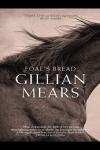
 I think my story compares with the struggles of the characters in Gillian Mears Foal’s Bread and Geraldine Brooks Year of Wonders, showing ordinary people trying to carry on living ordinary lives in the face of extraordinary circumstances, adversity and changing times. Though my book is more a crossover to mainstream fiction than literary.
I think my story compares with the struggles of the characters in Gillian Mears Foal’s Bread and Geraldine Brooks Year of Wonders, showing ordinary people trying to carry on living ordinary lives in the face of extraordinary circumstances, adversity and changing times. Though my book is more a crossover to mainstream fiction than literary.
9) Who or what inspired you to write this book?
Beyond the visit to Wonthaggi (discussed in question two) and my love of history and the Great War era, my great-grandparents’ journey to Australia inspired me. That challenge and their courage in uprooting their family and lives, for a new start in a country so far away, ignited a passion in me for the immigrant journey, particularly one that occurred during a time of enormous change, especially for women. Beyond the parallel migration journey, the story of The Swing Tree is entirely fictional.
10) What else about the book might pique the reader’s interest?
I believe readers will be interested in the female viewpoint shown of life on the home-front during World War One as opposed to the more frequently portrayed male viewpoint and life in the trenches. Life in Australia during WW1 was quite different for women compared to wartime life for women in United Kingdom, where women were encouraged to take over the jobs of men, drive ambulances, work in factories. Here, women’s war effort was confined to knitting and sewing for the troops, unless they were involved in the Red Cross. This proved frustrating and ground-breaking times for women here attempting to expand their roles, yet, many women had to take on the role of breadwinner when the men returned “changed” and often unfit to hold down fulltime jobs. Shellshock was yet to be recognised.

By:
christinemareebell,
on 12/19/2012
Blog:
From Hook to Book
(
Login to Add to MyJacketFlap)
JacketFlap tags:
My writing journey,
Musing on writerly topics,
Writing Tips,
Research,
Novel Writing,
Writing Journey,
Reading and Writing,
The Creative Process,
Writing a Novel,
Where do Ideas Come From?,
Master of Creative Writing,
RMIT Graduation,
Add a tag
 The first time I was asked: “What is the big question in your novel?” I responded with a blank look.
The first time I was asked: “What is the big question in your novel?” I responded with a blank look.
BIG question??? Hmm! Hadn’t really thought about a BIG question. I was just writing what I hoped was a cracker of a story and following my main character’s journey through a testing and changing time for women during the era of The Great War.
“Wrong. No! You must be writing to answer a question,” insisted my uni research tutor.
Really!???
Turned out, I was actually asking and exploring quite a few questions, but it took me some considerable effort to seek them out and, even more so, to articulate them and find the core question.
Being an historical novel, I thought, at first, that my questions would be very different to those that might be posed in a contemporary story. I considered them to be all about a woman’s right to happiness and did they have any rights to it, over duty, in the era of 1912 – 1920? I thought the question not relevant to young women in western society today, who often have so many choices.
Eventually I worked the major question in my novel through to:
At what point do we question the rightness and rationale of what we’ve been taught? (Or should we?)
Of course, this turned out to be a timeless question, relevant to as many women/people in the world today as much as a century ago. A right of passage and a question that – in some form – has been explored and debated in books the world over – through every genre.
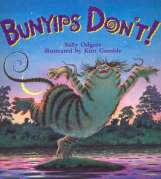 I remember having a debate with my Writing for Children tutor, several years ago, when I wrote a glowing review on the picture book Bunyips Don’t by Sally Odgers and illustrated by Kim Gamble. My tutor maintained how could the book end with a celebration when Young Bunyip had moved to the sunny side of the swamp with new friends leaving old Bunyip alone? To her, Young Bunyip was bucking his heritage and a selfish creature for deserting Old Bunyip. I argued that Young Bunyip tried to encourage miserable Old Bunyip, living in the dank and dark, that he could dance and play (be happy) on the sunny side of the swamp and to come with him. Old Bunyip chose not to just because Bunyips Don’t dance and play and live on the sunny side. He chose to live the same old unhappy life rather than make a choice to change. In the end, my tutor was more convinced but still struggled with Young Bunyip “abandoning” his heritage and his kind’s way of life.
I remember having a debate with my Writing for Children tutor, several years ago, when I wrote a glowing review on the picture book Bunyips Don’t by Sally Odgers and illustrated by Kim Gamble. My tutor maintained how could the book end with a celebration when Young Bunyip had moved to the sunny side of the swamp with new friends leaving old Bunyip alone? To her, Young Bunyip was bucking his heritage and a selfish creature for deserting Old Bunyip. I argued that Young Bunyip tried to encourage miserable Old Bunyip, living in the dank and dark, that he could dance and play (be happy) on the sunny side of the swamp and to come with him. Old Bunyip chose not to just because Bunyips Don’t dance and play and live on the sunny side. He chose to live the same old unhappy life rather than make a choice to change. In the end, my tutor was more convinced but still struggled with Young Bunyip “abandoning” his heritage and his kind’s way of life.
Doesn’t enjoyment and love for a book often come down to reader perspective?
If I hadn’t been going to uni, would I have ultimately learned as much just in the writing of my novel and formulated the same BIG question? Perhaps!
But the scope of my Master’s degree insisted I explore and articulate the social context and big question of my novel leading me to discover and thrill to what I discovered were the many layers to my story. Many intentional but some that I found had emerged organically too.
 So last week, I walked the ramp to the RMIT graduation stage with a huge grin on my face and grasped my degree, very pleased and proud to be a Master of Creative Media (Creative Writing) with Distinction.
So last week, I walked the ramp to the RMIT graduation stage with a huge grin on my face and grasped my degree, very pleased and proud to be a Master of Creative Media (Creative Writing) with Distinction.
Now – onward to get my novel published. And discover the BIG question in my new manuscript/s.
Often I hear writers asked, did your idea spring from plot, character or setting? Not, what question are you asking. So I’m asking you: Do you write with a BIG question in mind?
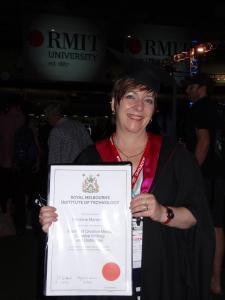


I’m really delighted to welcome debut author Dimity Powell to From Hook to Book and congratulate her on the launch of her exciting new chapter book Who Stole Santa’s Mail? published by Morris Publishing Australia.
Welcome, Dimity, and thanks for stopping by to answer some questions about the creation of your story and celebrate the publication of your very first book.
Let’s get started with an easy question.
Can you describe your book in five words or less?
Presents, elves, mayhem, it’s Christmas!
Of course, next, I have to ask how did the idea/s for the story come to you?
The original manuscript was the result of an assignment required for the completion of my Writing for Children Course back in 2008. The initial idea stimulus came from a newspaper article about how local council was rumoured to take away post boxes on the Gold Coast thereby decreasing their numbers dramatically or perhaps entirely. I thought this would make a good light-hearted mystery novel based on the ‘what if all the post boxes in a small boy’s town suddenly and inexplicably disappeared just two weeks before Christmas?’
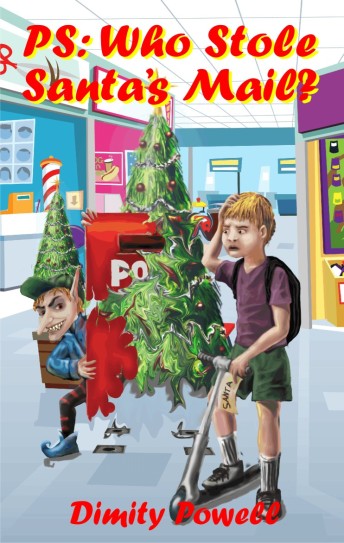
What would you most like readers to take from your story?
That there really is a Santa Claus! That Christmas is worth believing in. Oh, and that believing strongly enough in something and yourself can achieve great and magical things.
What led you to writing in the kid’s lit genre?
I delight in writing for children, especially those in the ‘golden age’ of independent reading. They seem have a greater propensity to believe in magic and that anything and everything is possible at that age while paradoxically being the hardest to convince. I find this simultaneously challenging and rewarding.
Does the life of your main character parallel yours in any way?
Yes. Sam is a firm believer in Santa Claus, as am I (hand on heart). Apart from that, I’m not as good on a scooter as Sam is and I don’t hang out in shopping plazas much.
How did you become a writer?
Like most people, I went to school first. My happy place was in the world of books and reading, which led me to spending long hours penning stories about lost ponies. In English class, I loved composition exercises the most. And to this day have never forgiven my Year 8 English teacher for ‘losing’ a story that had taken me weeks to perfect – an anthropomorphic tale about ants. Even at the tender age of 12, I suspected foul play. I never got it back and am still wondering why…
Can you tell me about your story’s main character, Sam, and what inspires you about him?
Sam is a likeable small town 8 year-old whose main mission in life is to ask Santa for his first really big present, his own bike. I love Sam’s determination to track down the missing post boxes and rescue his little sister, and the missing Christmas mail. He shows grit and courage but is not infallible and would not succeed at times if it weren’t for his close bumbling friend, Tobii. I’d like to have a mate like Sam; not too overbearing, not too perfect, but steadfast.
Who stole Santa’s Mail? uses different settings and we don’t know a whole lot about Santa, so did you have to do much research for the book?
I confess, I have never actually made it to Lapp Land, current residence of Santa Claus, but I have been to his birth place in Turkey, if that counts. Santa’s Winterworld is based on documentaries, articles and pictures I have seen and read of his Lapp Land home.
Congratulations, Dimity, on the launch of your first children’s book. I wish you and Who Stole Santa’s Mail? great success and sales. I’m sure we’ll be celebrating more books from you in the very near future. Meanwhile, I hope Santa brings you something truly wonderful and lots of writing time in 2013.
 In conjunction with Dimity’s blog tour, Morris Publishing invites you to enter the draw to win one of three copies of her book PS: Who Stole Santa’s Mail?
In conjunction with Dimity’s blog tour, Morris Publishing invites you to enter the draw to win one of three copies of her book PS: Who Stole Santa’s Mail? Send your answer to the question:
‘What do you think Santa wants for Christmas?’ to
[email protected]. In the subject line put,
PS: WSSM entry. The competition closes at midnight on November 30
th, 2012. All entries will be assigned a number that will be entered into the prize draw. Winners will be notified by email. If you are not the lucky winner, you can purchase the book at your local bookshop. Please ask them to order it in for you if it is not in stock. A signed copy can also be purchased from
http://morrispublishingaustralia.com.
You can follow Dimity’s blog tour at the following stops:
Tania McCartney, Susan KBR 17 November 2012
http://www.kids-bookreview.com
My Little Bookcase 18 November 2012
http://www.mylittlebookcase.com.au
Sheryl Gywther 19 November 2012
http://sherylgwyther.wordpress.com
Morris Publishing Australia 20 November 2012
http://morrispublishingaustralia.com
Kat Apel 21 November 2012
http://katswhiskers.wordpress.com/blog
Elaine Ouston 22 November 2012
http://elaineoustonauthor.com
Renee Taprell 23 November 2012
http://booksforlittlehands.blogspot.com.au
Alison Reynolds 24 November 2012
http://www.alisonreynolds.com.au
Buzz Words, Vicki Stanton 25 November 2012
http://buzzwordsmagazine.blogspot.com.au
Chris Bell From Hook to Book 26 November 2012
http://christinemareebell.wordpress.com
Dee White 27 November 2012
http://deescribewriting.wordpress.com
Jackie Hosking PIO 28 November 2012
http://www.jackiehoskingpio.wordpress.com
Alphabet Soup – Rebecca Newman 29 November 2012
http://soupblog.wordpress.com
Angela Sunde 30 November 2012
http://angelasunde.blogspot.com.au

 It’s time to put my office back together, after emptying it for new carpet, but I cringe to re-store all the boxes of old manuscript drafts and files. I’m wondering what to keep and what to chuck?
It’s time to put my office back together, after emptying it for new carpet, but I cringe to re-store all the boxes of old manuscript drafts and files. I’m wondering what to keep and what to chuck?
Even the tax man only makes me keep my paperwork three years. Am I just being precious keeping all these manuscript drafts of my published books, not to mention multiple drafts of many unpublished titles?
I’m so far distant from a paperless office I’m out the other side. In fact, adding much more paper, I will be – on the far side of the door. I truly don’t mind lots of books and paper stuff, but… seriously, it’s time to cull.
Surely even well-known authors who donate their work and boxes of manuscript to the Lu Rees Archives don’t keep everything? Or perhaps they do and that’s why they donate their life work when still living, to get the boxes out of their homes.
With that thought, I ducked into the website of the Lu Rees Archive to get an idea of what they do hold. Heaps, it seems, and, very interestingly, they also tell you how to look after your papers. I discovered I’m breaking all the taboos and shortening my paperwork’s life span by using metal pins, staples and rubber bands amongst other no-nos. The website explains that “metal rusts very quickly and leaves permanent marks. Rubber bands quickly disintegrate, leaving marks. Self-stick removable notes easily fall off, and when they do remain, may shift from the desired spot and leave a sticky residue. Sticky tape eventually loses its sticking capability and leaves marks as well as a residue. Liquid paper and correction tape wear off and crack.”
One great and surprising tip recommends using HB pencil to label your files etc, because pencil lasts for centuries and doesn’t damage like inks and pens. Lots to learn if fame ever finds me and my work.
But, since I’m not famous, yet, and running out of room, perhaps a mini cull would suffice.
How many or much do you keep of old drafts, notes and paperwork from your manuscripts? Is there a good reason to keep all or any of it? Please let me know your method and ideas in the comments?

Living in our house right now is like living in a renovator’s delight.
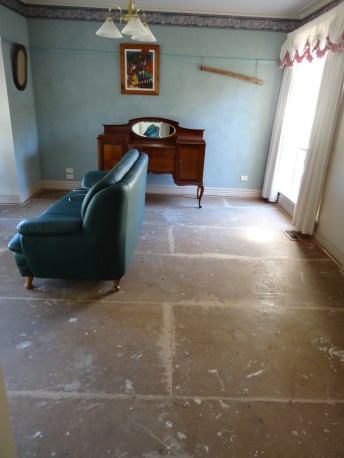 One simple makeover/reno job has upturned, upset and upended every single room in the house. (Much like a manuscript makeover does a story.)
One simple makeover/reno job has upturned, upset and upended every single room in the house. (Much like a manuscript makeover does a story.)
We started with a major expense project – new carpet – but not an overwhelmingly physical operation, one would assume. Then again we all know what happens when one assumes.
Long had Mr B complained about the unevenness of our floors and berated their long gone out-of-business builder, who built a lovely home, but took a few shortcuts and not just with the floor. (A bit like a writer thinking no one will notice that bit, being too busy taking in all the fabulous metaphors and striking similes.)
So we couldn’t do the simple take up and dump the carpet – or preferably pay someone else to break their backs doing it – and get our new carpet laid immediately. We needed to investigate the problem/s lurking beneath the underlay.
Do, do, do, do. Do, do, do, do! (Cue ominous Jaws theme here!)
 Yes, Mr B was right. (He has to be occasionally.) Those flooring sheets had peaked – pushed together unevenly, or swollen, as I’m told flooring is apt to do – ALL OVER THE HOUSE. Creating hills and valleys and now, some twelve-years post being laid, unsightly lines in the carpet. Not to mention the room where the builder’s flooring didn’t quite meet the walls, leaving gaps for dust and dirt to vent and over the years discolour the carpet along some edges.
Yes, Mr B was right. (He has to be occasionally.) Those flooring sheets had peaked – pushed together unevenly, or swollen, as I’m told flooring is apt to do – ALL OVER THE HOUSE. Creating hills and valleys and now, some twelve-years post being laid, unsightly lines in the carpet. Not to mention the room where the builder’s flooring didn’t quite meet the walls, leaving gaps for dust and dirt to vent and over the years discolour the carpet along some edges.
White carpet I might add. Not my choice, but it was here when we bought the house. So Mr B has had a big job planing off every join and now we are back on the level – bar the last two rooms to be done – albeit in a hell of a mess.
It seriously reminds me of trying to do a manuscript makeover and the more you do, the more problems you find or work needing to be done. And before you know it the manuscript that, before you fiddled, looked not far off ready, begins to look an insurmountable mess. Bits that need rewriting, moving, fixing and uneven bits found everywhere.
But then you approach it systematically, move some things, discard others, refresh a few gappy sections, and you begin to see what it could be. Still it’s damn daunting when everything’s pulled apart and you discover a few other tweaks timely. For example, a good time to paint a couple of walls too. Might as well while the landscape is clear and changes sparking fresh ideas.
It’s that creativity and new ideas that keep me inspired. I know it’s going to be great when it’s done.
 One added bonus/pest of our carpet makeover is that all my books had to exit the bookcase/s to take up the carpet. (Explaining why my office is one of those last two rooms due to the effort of packing and sorting “too” many books.) I know this looking at the fourteen packing boxes I’ve filled. And that doesn’t count the six full shopping bags I took to the op-shop.
One added bonus/pest of our carpet makeover is that all my books had to exit the bookcase/s to take up the carpet. (Explaining why my office is one of those last two rooms due to the effort of packing and sorting “too” many books.) I know this looking at the fourteen packing boxes I’ve filled. And that doesn’t count the six full shopping bags I took to the op-shop.
With a blog post in mind, I wrote down some of the titles of books I’ve sorted “to read” and the “keepers”, but like everything else in my office, I think those pages went into a box.
I feel a little guilty to be heading off to Tassie next week for research and leaving Mr B to finish on his own. But I’ll come back to oversee the new carpet being laid and begin the task of putting my house back in order.
I know I’m going to come back really inspired to get stuck into writing this new project, and that will prove a great impetus to get my house in order faster.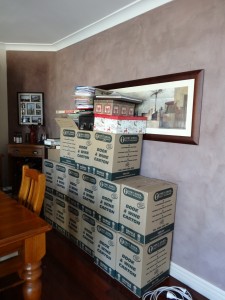

A lovely shot of encouragement for me this week with one of my novel manuscripts being long-listed in a major UK children’s writing competition.
 I’m a great believer in celebrating each and every writing milestone. Even the smaller stepping stones.
I’m a great believer in celebrating each and every writing milestone. Even the smaller stepping stones.
They give me, firstly, delight that a forward shift is happening and a great excuse to break out the bubbly. Plus they encourage me that publication of this novel might not be too far away. Secondly, competition awards and short/long-listings add to the CV and help build my writing credits, hopefully enhancing future submissions to agents and/or publishers. Thirdly, such milestones give me something to blog about.
I was glad I stuck to domestic bubbly when I found out the $43 Aust post charge to send the full manuscript to the UK. I wouldn’t want to do that every day, but it will be worth every cent if the manuscript is short-listed.
No matter whether it goes forward to a short-listing, I’m thrilled for the validation of this one, that is close to my heart, and I passionately believe is a great story.
Meanwhile, my fingers, toes, eye brows and everything are crossed for the next stage. Roll on December.

I find the current TAFE arts funding cuts and fee increases so sad and disappointing.
Fifteen years ago, I drove past a sign down on the Mornington Penninsula with a screaming headline, DO YOU WANT TO BE A WRITER?
Yes, yes, yes, I had always wanted, dreamed, aspired to be a writer, but I’d always believed that writers were somehow born – not made, taught, trained. The poster provided a website to a TAFE Diploma of Professional Writing and Editing course and to my absolute excitement told of a program that was hands-on, learning to write for publication and at an accessible fee rate. (At the time I was working one day a week to help supplement the family income and busy with three young children and what seemed then a hefty mortgage.) Uni was out of the question for me financially. Besides I wanted to write and be published. Theory was a luxury I could not afford to pursue. Not then.
I feel a deep sadness for all those with a writing dream and unfostered talent that may now not get to explore their creativity or potential to produce publishable work. (Many writers need such a supportive, encouraging environment to get started and gain confidence not to mention crafting techniques.) The destruction of TAFE is short-sighted on so many other employment pathways too that I won’t attempt to go into here.
I thank God that I saw my future on that billboard and raced to chase the call. It screamed to me and I feel so sad for all those who will not hear the cry, because without it some will never have the confidence, craft or encouragement to answer.
So many of my writer friends and colleagues graduated through the TAFE Professional Writing & Editing Diploma. Many like me believe it was a fantastic grounding and beginning to our lifelong writing apprenticeships. I’d love anyone reading this to leave a comment and let me know how they and their writing careers benefitted from TAFE or any formal writing courses.

Congratulations to Dale Harcombe WINNER of a Sally Odgers e-book for her comment on Bushland Lullaby.
 It’s an odd juxtaposition awarding Dale the prize considering I won a like e-book for posting a comment on Dale’s post with Sally on her Read and Write with Dale blog. Still I can assure that there has been no nepotism or favouritism. In fact, I wondered how to draw the winner and was about to pull names from a hat (really a coffee cup) when I surfed the net for more inventive ideas and chanced across the Random.org website. You simply input the number of entries i.e. comments between one and however many and it randomly selects your winner. Number three was Dale’s comment and VOILA… she wins one of Sally’s e-books on either Writing a Picture Book Text; Finding Farholt Or Writing Metrical Verse.
It’s an odd juxtaposition awarding Dale the prize considering I won a like e-book for posting a comment on Dale’s post with Sally on her Read and Write with Dale blog. Still I can assure that there has been no nepotism or favouritism. In fact, I wondered how to draw the winner and was about to pull names from a hat (really a coffee cup) when I surfed the net for more inventive ideas and chanced across the Random.org website. You simply input the number of entries i.e. comments between one and however many and it randomly selects your winner. Number three was Dale’s comment and VOILA… she wins one of Sally’s e-books on either Writing a Picture Book Text; Finding Farholt Or Writing Metrical Verse.
For the record, I’m excited to have won Sally’s writing picture book ebook. I love the picture book format, and have had a couple published, but I do struggle with the economy of words.
Please let me know in a comment, Dale, which book you’d like for your prize and it will be on its way instantly. Such is a the bonus in ebook delivery. No waiting for the printing, packing, posting.

Today, I’m very pleased to welcome to From Hook to Book prolific author Sally Odgers in celebration of the release of her beautiful new picture book Bushland Lullaby, illustrated by the very talented Lisa Stewart.
Sally is the awe-inspiring author of 300+ books and co-author (along with her husband Darrel) of the very popular Jack Russell: Dog Detective and Pet Vet series. Sally published her first book at nineteen and has kept busy ever since writing picture books, poetry, novels and multiple series.
 Since one of the major themes of this blog is research, I invited Sally to write her guest post about her research in finding and selecting the animals for Bushland Lullaby. I wanted to know what type of research is needed for a shorter book? And how she decided what to put in and what to leave out?
Since one of the major themes of this blog is research, I invited Sally to write her guest post about her research in finding and selecting the animals for Bushland Lullaby. I wanted to know what type of research is needed for a shorter book? And how she decided what to put in and what to leave out?
Welcome, Sally, and congratulations on your gorgeous new book baby.
Hi, Chris and thanks for having me.
Writing Bushland Lullaby was a joy, as it allowed me to use three of my favourite things; metrical verse, animals, the bush and word-play. Well, that’s four, but never mind.
I wanted to include a lot of animals in the text and the choice was difficult. I knew I had to use iconic Australians like the platypus, wombat, koala and emu, but I wanted to use less-expected creatures too.
In the end, I went for an eclectic mix of the very familiar and some others that might not immediately spring to mind. The first is the bandicoot. I am fond of “hannahoots” (that’s family-speak) so I had to have one of those. Next comes the possum, with which I have a strange relationship. I love our native ringies, but wish the brushies would NOT kill my plants and tantalise the dogs.
Crocs and goannas may not be to everyone’s taste, but they are true-blue Aussies, and remind me of trips to the far north. The seagull and penguin chicks are possibly less obvious choices, but I wanted birds. I would usually have included a cockatoo, but this time I didn’t because they’re not restful! I went for a wallaby rather than a kangaroo because they are cosier somehow, and I often see them when walking in the bush. The fruit bat and dingo round out the slightly-unexpected because I have fond memories of the bats hanging like abandoned umbrellas in northern trees and I thought the dingo pups should be there as a salute to the newcomer-Aussies.
There were so many others I’d love to have included, such as quolls, betongs, bilbies, dolphins, sugar gliders, and echidnas, but length is always a consideration in picture books and the text had to fit the traditional format.
Another concern was for the illustrator. Lisa was the perfect choice for the pictures, but I didn’t know who would be illustrating the text when I wrote it. I did, however, know that illustrators need something to grab hold of, and so I wanted the pictures to be sufficiently different. That meant I couldn’t include too many look-alike creatures. I did slip up a bit in the last verse though – I never thought to wonder how on earth THAT could be illustrated. Lisa worked out a wonderful way, though.
As for wording, I tried not to go for the expected words and rhymes. I don’t care for too-simplistic verse. One of my favourite stanza must serve as an illustration here;
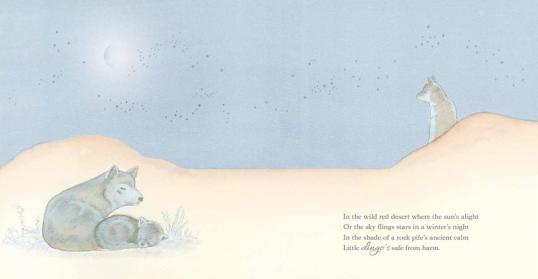
In the wild red desert where the sun’s alight
Or the sky flings stars in a winter’s night
In the shade of a rock pile’s ancient calm
Little dingo’s safe from harm.
And yes, choosing an aa/bb rhyme scheme possibly wasn’t the easiest idea I could have had!
Thank you, Sally, for sharing how and why you chose your bushland babies. It gives great insight into the collaborative relationship between author and illustrator, even with no discussion or meeting between them. Congratulations on providing such great scope for diversity of animals and habitats that reflects in Lisa’s wonderful illustrations. Children will love these bush babies and your gentle rhyme and gorgeous lyricism.
Congratulations on this gorgeous new picture book.
Chris
Comment to WIN: Sally is generously offering anyone who comments on this post an entry into a draw to win one of her three PDF writing e-books. Simply state your title preference when commenting to win one of the following:
- Writing a Picture Book Text
- Finding Farholt
- Writing Metrical Verse
Bushland Lullaby is published by Scholastic Australia 2012 ISBN: 9781742831770
To celebrate the release Sally will be touring the blogosphere. To follow her tour and learn more about her writing tips and this gorgeous new picture book, click on the links below.
Spinning Pearls – Sally Odgers
1st September 2012
Writing for Children – Peter Taylor
3rd September 2012
From Hook to Book – Chris Bell
7th September 2012
Kids’ Book Review – Tania McCartney
8th September 2012
Reading and Writing with Dale Harcombe
12th September 2012
School Magazine with Jackie Hosking
18th September 2012
Robyn Opie Parnell
23rd September 2012

 I am thrilled to welcome a very special guest to From Hook to Book today, my good friend and writing buddy, Alison Reynolds, to celebrate the launch of her fabulous new picture book A Year with Marmalade.
I am thrilled to welcome a very special guest to From Hook to Book today, my good friend and writing buddy, Alison Reynolds, to celebrate the launch of her fabulous new picture book A Year with Marmalade.
A Year with Marmalade, illustrated by the very talented Heath McKenzie, is the delightful tale of two good friends Maddy and Ella who find everything changes the day Maddy has to go away. Maddy cannot take her precious cat Marmalade and so she entrusts him to Ella’s care, but Marmalade and Ella do not even like one another. Through the seasons of one year Ella and Marmalade share adventures and a budding friendship.
This is a gorgeous picture book on every level, from its delightful prose and story, the wonderful illustrations and use of colour, through to the fabulous design where the playful and distinct arrangement of the text and fonts work to enhance meaning and fun in the illustrations and text.
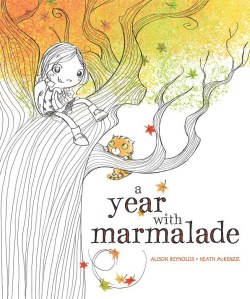 Alison Reynolds is the prolific author of over 30 books, including the fantastic choose-your-own-adventure Ranger in Danger series and the gorgeous Why I love… and Baby Talk series. She writes across the entire spectrum from board books, picture books, chapter books through to novels. How does she do it? It makes me want to know if there’s a difference in her writing process between these different genres? Time to ask her a few questions.
Alison Reynolds is the prolific author of over 30 books, including the fantastic choose-your-own-adventure Ranger in Danger series and the gorgeous Why I love… and Baby Talk series. She writes across the entire spectrum from board books, picture books, chapter books through to novels. How does she do it? It makes me want to know if there’s a difference in her writing process between these different genres? Time to ask her a few questions.
Welcome Alison. It’s fantastic to have you visit today.
Hi Chris. It’s very special to be here with you for the last day of the blog tour.
Let me start by asking you, when you get your story ideas, do they arrive fully formed, specifically as picture/chapter/novel ideas or do you work them into the genre you want to write? How do you decide which format an idea best suits?
For the last few years I’ve been doing commissioned work so the formats have been decided by the publishers. I would love to say my ideas arrive fully formed, but unfortunately they don’t. Sometimes I have a scrap of a conversation twisting around my mind. Or an image of something. A Year with Marmalade originated in an image of a cat in a tree looking on, and feeling unloved. It was perfect for a picture book. I think sometimes that many chapter books could be picture books because they are really “cluttered one idea” books. (I’ve been guilty of this.)
Sometimes, a picture book should be a chapter book, but I have found that sometimes you think you need the extra words, but when you look at it closely you don’t have enough plot to justify a chapter book. For me, less words are practically always better.
What differences do you find in your writing process between sitting down to create a picture book and say writing a novel?
I start both with a vague idea or image. I do tend to write picture books in longhand, while I’m very comfortable writing straight on the computer for a novel.
I also write a picture book extremely fast, but I tend to write novels much more slowly. Maybe I am pacing myself! I don’t find either much easier or harder, just different.
Do you have any rituals or habits you follow when writing or to get you into writing mode?
What you want me to tell you how I’m always at my desk at nine every day? That only happens in my every hopeful imagination.
I can’t write in a dressing gown and need to be fully dressed so I’m in work mode. I usually have music. My poor family suffers when I play the same two or three dvds constantly while I’m working on a project. It needs to be music that I know so I don’t listen too intently. I went through a Johnny Cash phase that I’m not sure everybody enjoyed. It gets to the stage if I’m out and I hear the music I feel as if I could start writing. Very Pavlov’s dog.
When I am near a deadline I write every day and work ridiculous hours. I’m a binge writer, but I wish I wasn’t!
When I’m on holidays I rarely write, but my little brain keeps ticking over.
When I’m stuck I’ve been known to flee to the local library or coffee shops. I’ve found that really helps.
Are you a visual writer? Does this visualisation change between your writing of a picture book text and a novel text?
I’ve become much more of a visual writer since I’ve been writing a spate of picture books. Picture books really are a different way of looking at the world. It’s important to have something different on every spread to illustrate. In A Year With Marmalade, I loved how Heath McKenzie dived in the spaces I left for him and created something even better than I could imagine.
I’m currently writing a YA and I feel as if I am much more of a visual writer than I used to be. The scenes roll across my mind and I could tell you exactly what each character is wearing. Writing visually is infectious!
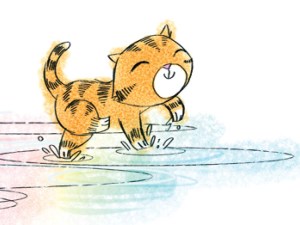 Marmalade and his friends are so cute. Can you see them having further adventures?
Marmalade and his friends are so cute. Can you see them having further adventures?
Chris, I would love to write another Marmalade adventure. I could imagine him in a talent show or lost.
Thank you so much for dropping by and answering my questions, Alison. I love all your books and wish you and Heath every success and mega sales for A Year with Marmalade.
A Year with Marmalade is published by Five Mile Press ISBN: 9781742488806
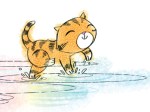 A Year with Marmalade Competition (LAST CHANCE TO ENTER)
A Year with Marmalade Competition (LAST CHANCE TO ENTER)
Marmalade’s personality really shines through in Alison Reynolds and Heath McKenzie’s newest picture book A Year with Marmalade. Share your favourite picture showing your cat’s personality to win.
The winner will receive a signed copy of A Year with Marmalade and a copy of the picture book Lighty Faust the Lion, a book about a much bigger cat.
Share your favourite picture of your cat by uploading it to author Alison Reynolds’ Facebook page at https://www.facebook.com/alison.reynolds.524 or email it to Alison as a low res jpeg file at [email protected] and she’ll upload it on her website www.alisonreynolds.com.au
Entries close on the 1st of September.
Today’s visit wraps up a busy blog tour by Alison Reynolds and Heath McKenzie and, if you’ve missed any of their stops, you can catch up with their other terrific tips and insights into writing and illustrating at the following tour links: (Also check out their websites at http://www.alisonreynolds.com.au and http://www.heathmck.com.)
Tour Stops:
7th August Dee White (Picture Book Writing Tips)
http://deescribewriting.wordpress.com
9th August Karen Tyrrell (How to Get Published)
http://www.karentyrrell.com/tag/karens-blog
11th August Tania McCartney (Review)
http://www.kids-bookreview.com
13th August Pass It On (The Marmalade Journey)
http://jackiehoskingpio.wordpress.com/school-magazine
14th August Kathryn Apel (Let’s Get Catty – a competition)
http://katswhiskers.wordpress.com/blog
17th August Dale Harcombe (Review and interview)
http://orangedale.livejournal.com
20th August Peter Taylor (How the Book was Created)
http://writing-for-children.blogspot.com.au
22nd August Susan Stephenson (Review)
http://www.thebookchook.com
23rd August Robyn Opie Parnell (Writing a Picture Book)
http://robynopie.blogspot.com.au
27th August Sally Odgers (5 Reasons to write picture books)
http://spinningpearls.blogspot.com.au
29th August Angela Sunde (Illustrating Marmalade – the process with Heath McKenzie)
http://angelasunde.blogspot.com.au
31st August Chris Bell (Writing Across Genres)
http://christinemareebell.wordpress.com

 Going back through my old word doc’s spanning ten years, I came across some old friends as well as some cringe worthy try-hards.
Going back through my old word doc’s spanning ten years, I came across some old friends as well as some cringe worthy try-hards.
I’m talking about old story files. Some with unrecognisable names – only to open the doc and discover that “Baldy” and “Blue Cap Boy” were early renderings of my Nelson title “Darcy Devlin and the Mystery Boy”. Funny to read some of those early drafts. Characters names changed, plots changed, my God, the writing quality changed. Looking back I can see how far my writing has come.
It was inspiring to find some old friends, a few who may yet see print. Some stood up well to a revisit and are now resaved in a current folder to work on. Some pieces sent me ducking for cover. Oooh! Did I write that? A few I’m embarrassed to say were even sent out to publishers: way too prematurely without earning the price of their postage.
It was fantastic to see the metamorphous of most stories. How they developed and improved and then found publication. (Not too many fell onto the page and converted to contracts, though a select few did.) The exercise proved the endurance of my apprenticeship, which is what I believe this past decade plus to be.
Thank goodness, most manuscripts improve dramatically with redrafting. This proved itself even more when I opened an early version of my current adult historical novel. I thought it was developing pretty well a couple of years ago, but I laugh now to see the overwriting and so many bits that are now gone. Some that I loved too. Then there were the gems that have been there from the start.
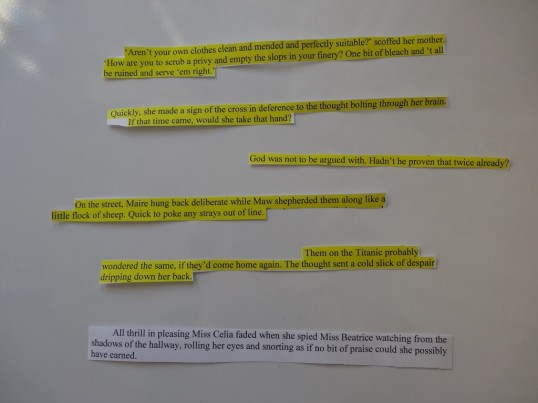 In the last couple of months, I’ve had murder on my mind. So many of my darlings to kill; some beautifully crafted sentences and descriptions that I worked and reworked, tweaked and loved, yet still had to guillotine and be ruthless about which had earned their place. Did they push forward the story, the characters, the plot? Sadly, some did not. They had to go. Some spent weeks highlighted in yellow because I did not want to give them up. And then as I read the manuscript without those words, I could see they did not need to be there.
In the last couple of months, I’ve had murder on my mind. So many of my darlings to kill; some beautifully crafted sentences and descriptions that I worked and reworked, tweaked and loved, yet still had to guillotine and be ruthless about which had earned their place. Did they push forward the story, the characters, the plot? Sadly, some did not. They had to go. Some spent weeks highlighted in yellow because I did not want to give them up. And then as I read the manuscript without those words, I could see they did not need to be there.
Of course, I kept those that add atmosphere, setting and tone to the story, but I became hard-hearted as to which did and did not add to these things. Sometimes, the words were not too shabby (even if I do say so myself) but too much detail. Hit that delete button.
I also worked hard at turning my main character’s face to the camera. Turning exposition and narration into her viewpoint, which in turn reduced extraneous detail. All of it beautiful prose, I’ve been told, but not all of it necessary. So cut – more words gone.
I even chopped another character out of existence. She was a lovely moment in the story with a couple of loose connections, but she had no impact on the story or real reason for existing beyond set decoration. Goodbye Lily.
I can honestly say the manuscript is tighter for these departures. The pace has picked up and in turn I believe the page turning drive increased.
What a journey? What a rollercoaster ride?
It’s been fantastic looking back where I’ve come from, but I’m totally excited at where I’m heading with my historical novel not too far off ready to go out into the world.
What’s your writing journey? Where are you on the path? How many drafts do you do? Or do you find, like me, as many as it takes?

 When one of my blog commenters, a new writer, asked me a couple of posts ago what tips did I have for new writers, I thought why not share them in a blog post too.
When one of my blog commenters, a new writer, asked me a couple of posts ago what tips did I have for new writers, I thought why not share them in a blog post too.
- Write every day
- Read widely – the masters, classics, short stories, poetry and contemporary fiction. Learn to read as a writer. Ask how did the writer make this work? What techniques is the writer using? How does the writer achieve this effect?
- Write the story you want to write; the story you believe in; write from the heart. This is the kind of story that will reach out from the page: touch your heart or grip you by the throat. (Maybe not in the first draft, but if the essence is there, and the writer’s passion, the rest can be redrafted, edited, polished to brilliance.)
- Seek feedback – find a critique buddy. Utilise what resonates. Mull the opinions before discarding any not in tune with your intention for your story. What may sting at first can be found to be gold a few days later.
- Write because you love it as your first priority. Publication is a bonus, but aim for it. (If you have a story worth telling, you want it to be read.)
- Experiment: try different styles of writing, don’t stick to just what you know or the way/style you always write.
- Up the stakes/conflict: Always ask, have I gone far enough?
- Play with language/Experiment with voice
- Sign up for a short course through your state/local writers’ centre: some expert guidance and ground rules can save years of trial and error and frustration.
- Redraft/edit/proofread diligently
- Put your work away for a week (or better several). Fresh eyes see many jolts and jars and inconsistencies in the writing.
- Submit – get your work out there to be read OR Enter competitions – gain writing credits and confidence.
- Persevere and Persist: the essential Ps and two most important attributes for writers. These can win out over raw talent. Meanwhile you’re learning your craft. It’s the apprenticeship.
Enjoy the roller coaster. It’s a really scary ride, but worth it if you hold your nerve.
Love to know if any writers reading this have any tips they’d like to share or what do you wish you’d known when you started out?

Mid-way through the year, I realise my pledge to read 52 books in this Year of Reading may have been a bit of an over-estimation on my part. Hey, I know what went wrong, I should have aimed for shorter books. All the ones I’m reading are hundreds of pages long. So from now on, I’m going to leave off the number of books I’m up to and just enjoy the reading.

I’m back into reading the era I’m about to write again for my new historical novel, set during and post WW1. I’m not usually one for war movies or books depicting the grit and gore of battles. My passion lies in the personal, emotional and psychological journeys of my characters, living through those times, but for me to understand how they think, feel and react I must read the books. Some are harsh; so is war. The more I read, the more I cannot believe that WW1 is not a key focus in our education system. Before I began researching four years ago, you could have grown crops of wheat to feed whole suburbs in the gaps in my knowledge. I still have so much to learn, as evidenced in my research trip, but I’m engrossed and passionate about the people and the time enough to set and write another historical saga in the same era as my previous novel. Plus I really need to write and learn more in order to understand what went on and what it was for.
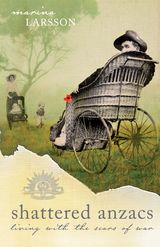 Shattered Anzacs living with the scars of war by Marina Larsson
Shattered Anzacs living with the scars of war by Marina Larsson
Historian and author Marina Larsson explores the impact of war disability on the lives of soldiers and those of their families upon their return from WW1. Larsson comprehensively details the effects and attitudes of society, the government, and real families utilising interviews with the offspring of returned soldiers of WW1. Larsson’s text is accessible and highly readable, despite the incredible breadth of her research. The text explores the effects of having a soldier living in the household with an ongoing disability, often a “nervy” and “changed” man. It further addresses the financial and physical effects and impact on disabled WW1 returned soldiers’ employment prospects. I highly recommend this excellent resource for anyone writing on the experience and legacy of war.
University of New South Wales Press, Sydney 2009
ISBN: 9781921410550
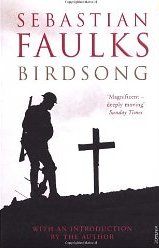 Birdsong by Sebastian Faulks
Birdsong by Sebastian Faulks
The strength of Birdsong is Faulk’s authentic battle scene descriptions and their shocking psychological effects on the men fighting. He takes you into the trenches and onto the battlefield. And he doesn’t let you escape a single moment of the unrelenting battle morning where tens of thousands went over top to be mown down, caught on the wire or tripped up in the bodies of their mates. Events in the past are described in captivating detail – as if it’s happening now. The character progression of the main character, Stephen Wraysford, an initially selfish young man who seduces his host’s wife and whom appears to care about nothing and no one, is riveting. Alternating viewpoints enable a steady progression in Wraysford’s mental deterioration and those of his men.
I enjoyed “most” of Birdsong. Except for the modern day viewpoint of Wraysford’s grand-daughter, which to me add
Stepping into one of the most iconic bookshops in the world is an almost holy moment, whether you’re religious or not. And a visit to Shakespeare and Company was one of my “must-dos” during my research trip to Paris.
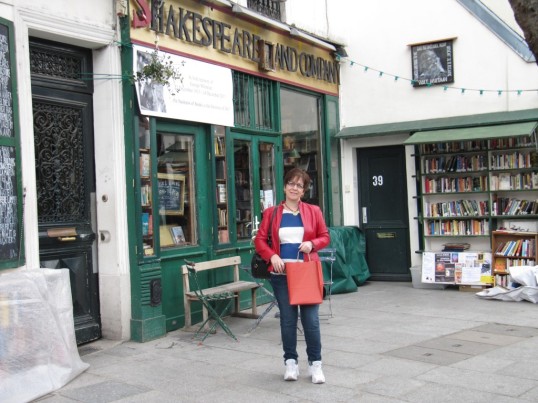 Shakespeare and Company bookshop has existed in Paris in two forms; the first was opened by Sylvia Beach in 1919 and frequented by such masters as Hemingway, Fitzgerald, Joyce and Ezra Pound. The shop closed in 1941 during the German Occupation after Beach refused to sell a book to a German Officer. He threatened to return and remove every book, but hours later, thanks to Sylvia’s friends, she had emptied the shop of every book, painted over the front, and closed the doors permanently. The second store came into existence after Beach’s death in 1964 when George Whitman renamed his “Le Mistral” bookshop, on rue de la Bûcherie, in her honour.
Shakespeare and Company bookshop has existed in Paris in two forms; the first was opened by Sylvia Beach in 1919 and frequented by such masters as Hemingway, Fitzgerald, Joyce and Ezra Pound. The shop closed in 1941 during the German Occupation after Beach refused to sell a book to a German Officer. He threatened to return and remove every book, but hours later, thanks to Sylvia’s friends, she had emptied the shop of every book, painted over the front, and closed the doors permanently. The second store came into existence after Beach’s death in 1964 when George Whitman renamed his “Le Mistral” bookshop, on rue de la Bûcherie, in her honour.
 Whitman’s Shakespeare and Company, situated on the left bank opposite Notre Dame, also became an iconic cultural institution as bookstore, lending library and home to writers and poets, both published and not. Today, Shakespeare and Company is run by Sylvia Beach Whitman, George Whitman’s daughter, who maintains his creed allowing writers to live-in, read and write, in exchange for a couple of hours help a day in the shop. (George died only recently in December 2011 aged 98.)
Whitman’s Shakespeare and Company, situated on the left bank opposite Notre Dame, also became an iconic cultural institution as bookstore, lending library and home to writers and poets, both published and not. Today, Shakespeare and Company is run by Sylvia Beach Whitman, George Whitman’s daughter, who maintains his creed allowing writers to live-in, read and write, in exchange for a couple of hours help a day in the shop. (George died only recently in December 2011 aged 98.)
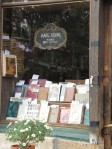 Books of every genre and description cram the floor-to-ceiling shelves and cluttered corners. Stacks of books line the staircase leading upstairs to the reading room and lending library – available to the public to read – including thousands of hardback biographies and histories.
Books of every genre and description cram the floor-to-ceiling shelves and cluttered corners. Stacks of books line the staircase leading upstairs to the reading room and lending library – available to the public to read – including thousands of hardback biographies and histories.
Time poor, I didn’t get to attend a weekly reading or any of the frequent workshops or writers’ meetings. It was enough to climb the narrow stairs to the tiny room available free to writing/reading groups and imagine myself with hours to spend sitting reading and absorbing the spirit of the great writers who’ve also visited such as Anais Nin and Henry Miller. I could so imagine curling up, notebook and pen in hand, writing in this space. Sigh!
 The shop sells mainly literary and contemporary fiction, both new and used books, and offers an incredible selection of mostly English print books. (Though they do sell some Russian, Spanish, German and Italian.) I picked up several, restricted sadly by the weight limit of an internal flight, including George Orwell’s Down and Out in Paris and London and Fitch’s Sylvia Beach and the Lost Generation (A History of Literary
The shop sells mainly literary and contemporary fiction, both new and used books, and offers an incredible selection of mostly English print books. (Though they do sell some Russian, Spanish, German and Italian.) I picked up several, restricted sadly by the weight limit of an internal flight, including George Orwell’s Down and Out in Paris and London and Fitch’s Sylvia Beach and the Lost Generation (A History of Literary
By:
christinemareebell,
on 6/7/2012
Blog:
From Hook to Book
(
Login to Add to MyJacketFlap)
JacketFlap tags:
Inspiration,
Research,
Writing Inspiration,
Writing Journey,
Story ideas,
The Creative Process,
My writing journey,
Musing on writerly topics,
Setting Research,
Add a tag
And people do. Incredibly generously. No matter where I go, if I ask a question and say I’m writing a book, mouths and doors open. Even when we barely speak the same language.
My recent research revealed that the location of French farmhouses, at least in the Somme area of France, aren’t like our Aussie farmhouses situated out in the middle of paddocks, far from town, but are located within the village, often on the main street.
 Big buildings with high wooden doors and entries, or perhaps steel for the more modern, can line the street, like in the photo here. Beyond the walls and doorways are the yard in the middle and the farmhouse at the back. When asked why farmhouses weren’t on the farm land, my guide explained that it’s safer in the village (in numbers) unlike being isolated out on the land alone. In a country invaded often over the centuries, this made a lot of sense.
Big buildings with high wooden doors and entries, or perhaps steel for the more modern, can line the street, like in the photo here. Beyond the walls and doorways are the yard in the middle and the farmhouse at the back. When asked why farmhouses weren’t on the farm land, my guide explained that it’s safer in the village (in numbers) unlike being isolated out on the land alone. In a country invaded often over the centuries, this made a lot of sense.
The farmyards’ location and set-out is integral to an important meeting of two central characters in my story and when I learned of their true location, I realised I’d set up their meeting all wrong. Only trouble was, since my guide wasn’t a farmer, how did I find out what lay behind the closed doors and gates of French farmyards to even begin to imagine their set out or setup? Many haven’t changed layout much over the century since the war, but, of course, most are much more modern in technology and living arrangements today.
Skulking along the main road of a small village seemed the closest I could get to seeing inside, snapping surreptitious photos through the odd door or gate left ajar. Until… My sidekick and I came across the huge house (pictured) next door to a “farmhouse”. When Jackie, as we came to know him, stepped out the farm gate to retrieve something from his car, we bade him ‘Bon jour,’ and when he responded in-kind, I took the opportunity to ask him how old was the house as a lead in to asking about the farm.
 He said he’d pop back and ask the owner of the “chateau” who was inside. Minutes later he returned and asked us to come in and meet the owner. Before we knew it, we were shaking hands with Jacques, Jean Claude and Jackie and explaining my interest as a writer in both the chateau and the farm. To my bemusement, Jean Claude started filming me while I interviewed Jacques. I feared, he may have misunderstood and thought me famous. The word writer seems to carry such weight. I started to explain that I was your garden variety writer, not discovered yet, but knew my words not understood by Jean Claude’s grin and failure to put down the camera, so we both continued to enjoy the moment.
He said he’d pop back and ask the owner of the “chateau” who was inside. Minutes later he returned and asked us to come in and meet the owner. Before we knew it, we were shaking hands with Jacques, Jean Claude and Jackie and explaining my interest as a writer in both the chateau and the farm. To my bemusement, Jean Claude started filming me while I interviewed Jacques. I feared, he may have misunderstood and thought me famous. The word writer seems to carry such weight. I started to explain that I was your garden variety writer, not discovered yet, but knew my words not understood by Jean Claude’s grin and failure to put down the camera, so we both continued to enjoy the moment.
Next thing, Annik, Jacque’s wife arrived and she very graciously took us off to show us through the lower floor of their delightful chateau. I was both awestruck and embarrassed, not having meant to impose so much on their kindness and generosity of spirit. My time with Annik stretched my French to surprising lengths and I found long forgotten phrases and words in my efforts to communicate with her. How could I forget, la fenêtre, the window and other such descriptions around the house from Form One French class? Sr Austin would be proud of me.
Annik and Jacques allowed me to take photos and answered all my questions. I also got to see through the disused farmhouse and imagine how it might have been when one of my characters lived there so very long ago. She may
Okay the writing journey is not as scary or fraught as this 1921 crossing of the Mekong by this intrepid and determined traveller and his (poor) brave steed.
 But, after lots of emails crossing paths in the ether all week from various writing buddies… I’m putting it out there. How can we writers inspire, buoy, encourage and fool ourselves into keeping steadfast on our journey to publication?
But, after lots of emails crossing paths in the ether all week from various writing buddies… I’m putting it out there. How can we writers inspire, buoy, encourage and fool ourselves into keeping steadfast on our journey to publication?
More often than not, it’s a long, long haul from Point A – the idea that inspired the story to Point B – publication.
Sounds simple enough. I mean how hard can it be? A few thousand words! How long can it take? A few months!
Turns out – not so easy. Not so fast. A novel isn’t written in a day, a week, a month or, for most us, even a year. It needs to evolve, develop and be written page by painful page, draft by draft. (Unless, of course, the muse is in town and on those golden days it verily hurtles along.)
We need sustenance along the way. Small incentives towards making the dream a reality and I’m not talking chocolate, a glass of bubbles on each chapter completed or trinkets in small velvet boxes. No, I mean some writerly stepping stones to support our self-belief and enthusiasm from point A to B. Because at some point along the path, there’ll be more quicksand than shore, more shale than stone under our feet. With no agent, or publisher beside us mopping our brows and waving the chequered flag, we can be the ones to flag. Our writing stalls and suddenly that brilliant idea seems trite, unoriginal and going nowhere.
 We don’t get a treasure map, or to kick the odd doubloon to tell us we’re on track. We shake the compass, but it only points north – as the crow flies. It doesn’t tell us the easy roads or shortcuts.
We don’t get a treasure map, or to kick the odd doubloon to tell us we’re on track. We shake the compass, but it only points north – as the crow flies. It doesn’t tell us the easy roads or shortcuts.
What we need is some tips to inspire and gain some kudos along the way – always great for the C.V. but more important, great for our confidence and self-belief.
Here’s my top ten stepping stones towards publication:
- WRITE – only words on the page can grow a story.
- Join a writing group (find kindred spirits who get what you’re doing, and offer real, productive critiquing that helps your work, builds your craft, and theirs, spiralling you all towards publication).
- Enter competitions – to gain confidence, writing credits and crafting competence. (Not to mention certificates for your achievements book. Okay, brag book, if you want to call it that. See tip 5)
- Submit to anthologies, magazines – to get your name out there, gain confidence, writing credits and inspiration to continue.
- Keep an achievement (display) book to keep copies of those small steps, Letters to the editor, commendations, reviews you’ve written – great to browse those milestones on days you need a reminder that you’re moving forward.
- Build a website – create a cyber presence, AND/OR create and maintain a blog – gain a voice, a following, a kinship with fellow bloggers. (Remember to comment on other blogs and exchange reciprocal links.)
- Rework your chapter, story, base premise, for fiction short markets, or find non-fiction links and submit to newspapers, magazines, journals, e-sources for publication, gain writing credits and link back to your WIP.
- Build your writing profile through social media i.e. Facebook, Twitter, Jacketflap, Linked
 Literally! And if a writer doesn’t stretch and move and shake those lower back muscles, boy, can they scream at you – just as my sciatic nerve has been screeching at me all week.
Literally! And if a writer doesn’t stretch and move and shake those lower back muscles, boy, can they scream at you – just as my sciatic nerve has been screeching at me all week.
“Do you have to write?” asked my physio.
Well, it is my income, my passion and my day job, spasmodically paid as it is, so yeah, I sort-of do need to write.
“Then you and your writing and your butt are going to have to learn to work (and NOT work so often) together.”
Now, after ignoring my manuscript, my blog, Facebook and as many other activities that require sitting as I can, enabling me to catch up on heaps of other things, I’m past the agony stage and into aggravating discomfort. I must be getting better. Seems like a good time to address the issue of back care for writers and other desk jockeys and sedentary types.
According to my physiotherapist, when we sit for long periods, everything contracts and compresses, and then presses onto nerves and muscles that don’t like it much and the only way they can tell us they hurt is to make us hurt worse.
So the tricks:
- Get up regularly and move around – stretch, bend and arch that back in a reverse position (walking stiffly to the kettle or the loo does not count)
- Walk regularly outside of the house – in the fresh air – go up hills and down dales and stretch all sorts of different muscles
- Ensure your desk chair is ergonomic and correctly positioned for your height, build and good posture.
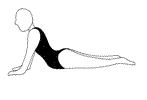 My physio has me doing a few gentle exercises to stretch out my muscles and extend my lower back that seem to be really helping. He’s a muscle maestro and my back’s new bf.
My physio has me doing a few gentle exercises to stretch out my muscles and extend my lower back that seem to be really helping. He’s a muscle maestro and my back’s new bf.
Next step – Pilates class.
In keeping with doctor’s orders that’s it for this short post – most of which was written standing up. Except to say, if you have any tips or advice for back care or good writerly ergonomics, I’d love you to leave them in the comments.





 2 Comments on Writing can be a pain in the butt, last added: 4/4/2012
2 Comments on Writing can be a pain in the butt, last added: 4/4/2012
 It’s that time of year to flex your writing muscles and get your entries in to the fantastic number of competitions and exciting opportunities open to young writers right now. You’ll find further details and some cool new resources on my Young Writers’ Resources page, such as writing residencies, including: three great KSP places in WA, the Ray Koppe Residency – offering a week at Varuna Writers’ House; writing conferences, including: CYA Hatchlings combined with the full CYA program in July 2013 and the National Young Writers Festival blasting off in October 2013, plus lots more competition details, events and workshops.
It’s that time of year to flex your writing muscles and get your entries in to the fantastic number of competitions and exciting opportunities open to young writers right now. You’ll find further details and some cool new resources on my Young Writers’ Resources page, such as writing residencies, including: three great KSP places in WA, the Ray Koppe Residency – offering a week at Varuna Writers’ House; writing conferences, including: CYA Hatchlings combined with the full CYA program in July 2013 and the National Young Writers Festival blasting off in October 2013, plus lots more competition details, events and workshops.













































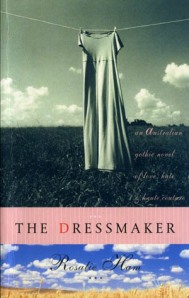


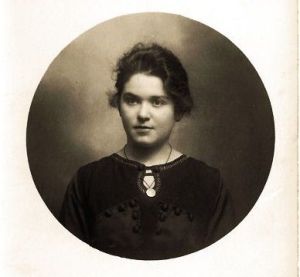
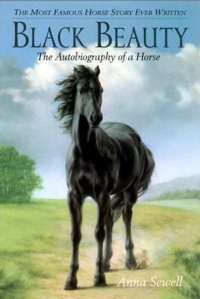
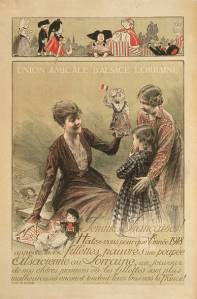
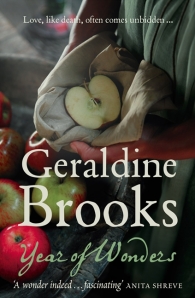
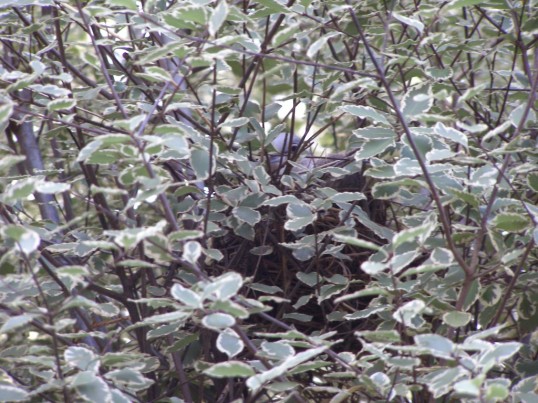


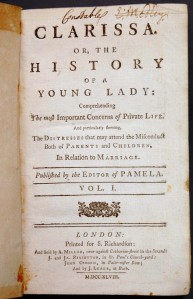

Hi Chris, Great suggestions and advice here. I tried to leave a comment but the box wouldn’t let me enter anything at all. Not sure whether it’s your end or mine. C.x
The Dog on the Tuckerbox – now out in paperback January 2013
Weekly Wednesday Blog Post http://corinnefenton.com/blog Website: http://www.corinnefenton.com http://www.scbwiaustralia.org http://www.walkerbooks.com.au/Black-Dog-Books
‘
Hi Corinne,
Well, your comment got through regardless. So all good and always great to see you here.
I’m excited about the opportunities out there for young writers, especially at this time of year.
This page always get a fabulous response and lots of views, so it’s wonderful to know that so many young writers are looking for chances to get their work out there
.
Best, Cxx